LF Energy Embedded Summit Recap: Implementing and Validating Linux Cyber Security Requirements: SEAPATH Case Study
In a rapidly evolving digital landscape, ensuring robust cyber security measures for Linux systems has become paramount, especially in critical infrastructure. At LF Energy Embedded Summit, Enguerrand de Ribaucourt and Mathieu Dupré of Savoir-faire Linux presented a case study on the SEAPATH project, which focuses on effectively implementing and validating Linux cybersecurity requirements.
SEAPATH: Enhancing Cybersecurity for Critical Infrastructure
Contributors to the LF Energy SEAPATH open source project have been coordinating with the Critical Public Infrastructure (CPAs) project. This project is dedicated to fortifying the security of critical infrastructure, such as electricity networks, and serves as a testament to the power of collective efforts in safeguarding digital ecosystems.
A Practical Approach to Cybersecurity
One of the key takeaways from the session was the SEAPATH team’s commitment to providing a practical and hands-on guide to implementing cybersecurity requirements. Rather than dwelling on high-level theoretical concepts, SEAPATH focuses on offering actionable insights that can be readily implemented across different Linux distributions. This approach bridges the gap between theory and practice, making it easier for organizations using SEAPATH to enhance their cybersecurity posture.
The Structure of the Guide
The SEAPATH guide is structured around 44 distinct security levels, each tailored to specific systems and use cases. These levels encompass a spectrum of complexity, from minimal security requirements applicable to any Linux device to heightened security measures for critical infrastructure applications. This comprehensive approach ensures that organizations of varying sizes and needs can find guidance that aligns with their specific security goals.
Key Topics Covered
SEAPATH’s guide delves into an array of critical topics, including:
– Compilation flags: Optimizing compilation processes to enhance security.
– File system permissions: Implementing stringent controls over file access.
– Kernel configuration: Fine-tuning the Linux kernel to minimize vulnerabilities.
– Network isolation and firewalling: Ensuring that network traffic is tightly controlled and monitored.
– Minimizing services: Streamlining the attack surface by removing unnecessary services.
– User configuration: Implementing secure user management practices.
Principles of Security
The presenters highlighted key principles that organizations should adopt to bolster the security of their Linux devices:
– Minimize features and privileges: Limit the scope of applications and user privileges to reduce potential attack vectors.
– Isolate and partition the network: Implement robust network segmentation to prevent lateral movement in case of a breach.
– Harden configurations: Enable security features and adhere to best practices to fortify system configurations.
Testing and Compliance
Ensuring compliance with recommended security measures is a critical aspect of the SEAPATH project. The team has developed a suite of tests that can be easily executed to validate the implementation of security requirements. A companion tool facilitates the alignment of CPAs test results with other established cybersecurity guidelines, enhancing the project’s interoperability and relevance across different standards.
The SEAPATH case study presented by Enguerrand de Ribaucourt and Mathieu Dupré underscores the significance of pragmatic cybersecurity practices in the Linux ecosystem. By providing a practical guide and comprehensive testing framework, SEAPATH empowers organizations to strengthen their cybersecurity defenses while contributing to the collective goal of enhancing the security of critical infrastructure. As digital threats continue to evolve, initiatives like SEAPATH serve as beacons of collaboration and innovation in the pursuit of a more secure digital future.
